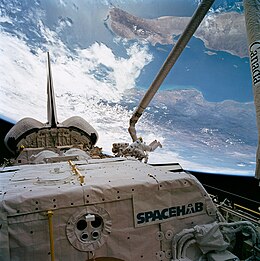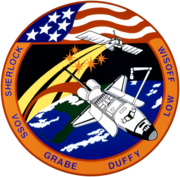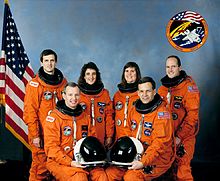STS-57

Endeavour's payload bay, with the SpaceHab module (foreground), EURECA (background), and astronauts Low and Wisoff performing an EVA (centre)
|
|||||
| Mission type | Biosciences Satellite retrieval |
||||
|---|---|---|---|---|---|
| Operator | NASA | ||||
| COSPAR ID | 1993-037A | ||||
| SATCAT № | 22684 | ||||
| Mission duration | 9 days, 23 hours, 44 minutes, 54 seconds | ||||
| Distance travelled | 6,608,628 kilometers (4,106,411 mi) | ||||
| Orbits completed | 155 | ||||
| Spacecraft properties | |||||
| Spacecraft | Space Shuttle Endeavour | ||||
| Landing mass | 101,657 kilograms (224,115 lb) | ||||
| Payload mass | 13,074 kilograms (28,823 lb) | ||||
| Crew | |||||
| Crew size | 6 | ||||
| Members |
Ronald J. Grabe Brian Duffy G. David Low Nancy J. Sherlock Peter J. Wisoff Janice E. Voss |
||||
| Start of mission | |||||
| Launch date | 21 June 1993, 13:07 UTC | ||||
| Launch site | Kennedy LC-39B | ||||
| End of mission | |||||
| Landing date | 1 July 1993, 12:52 UTC | ||||
| Landing site | Kennedy SLF Runway 33 | ||||
| Orbital parameters | |||||
| Reference system | Geocentric | ||||
| Regime | Low Earth | ||||
| Perigee | 402 kilometres (250 mi) | ||||
| Apogee | 471 kilometres (293 mi) | ||||
| Inclination | 28.45 degrees | ||||
| Period | 93.3 min | ||||
|
|
|||||


Left to right - Front row: Duffy, Grabe; Back row: Wisoff, Sherlock, Voss, Low
STS-57 was a Shuttle-Spacehab mission of Space Shuttle Endeavour that launched 21 June 1993 from Kennedy Space Center, Florida.
During the course of the ten-day flight, the astronauts successfully conducted scores of biomedical and materials sciences experiments inside the pressurized SPACEHAB module. Two astronauts participated in a spacewalk and EURECA (European Retrievable Carrier) was retrieved by the crew and stowed inside Endeavour’s payload bay. EURECA was deployed from the Space Shuttle Atlantis in the summer of 1992 and contains several experiments to study the long-term effects of exposure to microgravity.
An improperly installed electrical connector on Endeavour’s Remote Manipulator System (RMS) arm (installed 180 degrees off its correct position) prevented EURECA from recharging its batteries with orbiter power. A flight rule requiring anntenna stowage was waived and EURECA was lowered into the payload bay without latching its antenna. Mission Specialists G. David Low and Peter Wisoff safely secured EURECA's dual antennas against the science satellite during the spacewalk. David Low was mounted on a foot restraint on the end of Endeavour's robotic arm while Mission Specialist Nancy J. Sherlock positioned the arm so Low could gently push the arms against EURECA's latch mechanisms. Payload controllers then drove the latches to secure each antenna. The five-hour, 50 minute spacewalk completed STS-57 mission's primary goal of retrieving the EURECA science satellite. Afterwards, Low and Wisoff completed maneuvers for an abbreviated extravehicular activity (EVA) Detailed Test Objective using the robot arm. Activities associated with each of the areas of investigation—mass handling, mass fine alignment and high torque—were completed with both EVA crewmen taking turns on the robot arm. Low and Wisoff wrapped up their spacewalk and returned to Endeavour's airlock shortly before 3 pm Central.
...
Wikipedia
